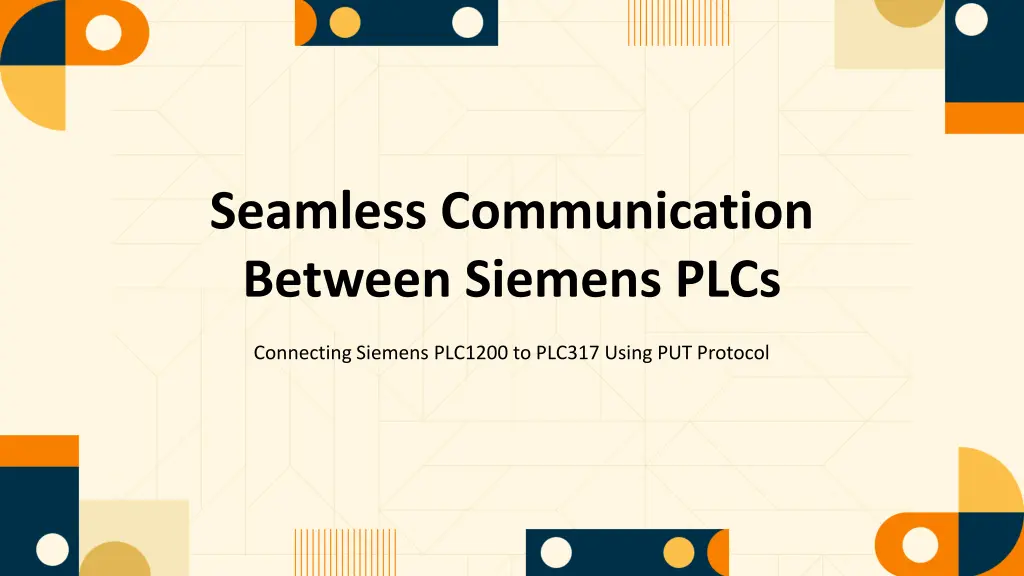
Seamless Communication Between Siemens PLCs: Integrating PLC1200 with PLC317 via PUT Protocol
Learn how to establish seamless communication between Siemens PLCs by connecting PLC1200 to PLC317 using the PUT protocol. Understand the importance of data transfer, local and remote PLC configurations, establishing connections, and more for efficient automation processes.
Download Presentation

Please find below an Image/Link to download the presentation.
The content on the website is provided AS IS for your information and personal use only. It may not be sold, licensed, or shared on other websites without obtaining consent from the author. If you encounter any issues during the download, it is possible that the publisher has removed the file from their server.
You are allowed to download the files provided on this website for personal or commercial use, subject to the condition that they are used lawfully. All files are the property of their respective owners.
The content on the website is provided AS IS for your information and personal use only. It may not be sold, licensed, or shared on other websites without obtaining consent from the author.
E N D
Presentation Transcript
Seamless Communication Between Siemens PLCs Connecting Siemens PLC1200 to PLC317 Using PUT Protocol
Table of content Local PLC Configuration Introduction to Siemens PLC PLC Communication Understanding the PUT Protocol 01 02 03 Remote PLC Configuration Establishing Connection Executing the PUT Command 05 06 04 Verifying Data Integrity Real-World Applications Future of PLC Communication 07 08 09
Table of content Conclusion Thank You! 10 11
Introduction to Siemens PLC Communication 01. Overview of PLCs 02. Siemens PLC Series Programmable Logic Controllers (PLCs) are essential in automation, enabling reliable communication between devices for efficient processes. Siemens PLC1200 and PLC317 are advanced PLCs PLCs designed to facilitate complex automation tasks. automation tasks.
Understanding the PUT Protocol 01. What is PUT? 02. Importance of Data Transfer The PUT protocol is a method of transferring data data from one PLC to another, ensuring seamless seamless integration in automation systems. Efficient data transfer is crucial for maintaining synchrony and consistency between local and remote remote PLCs.
Local PLC Configuration 01. DB Configuration 02. Building the DB The Data Block (DB) on the local PLC must be configured accurately to ensure compatibility with the remote PLC. Creating the DB involves defining the variables and and data structures that will be used in communication.
Remote PLC Configuration 01. Mirror the Local DB 02. Synchronization The remote PLC's DB must mirror the local PLC's DB configuration for successful data integration. Ensure both PLCs are synchronized to avoid data data discrepancies during transfer.
Establishing Connection 01. Network Setup 02. Testing the Connection Proper network settings are essential to facilitate communication between the local and remote PLCs. Before initiating data transfer, conduct tests to confirm a stable connection.
Executing the PUT Command 01. Sending Data 02. Error Handling Use the PUT command to initiate data transfer from the local PLC's DB to the remote PLC's DB. Implement error handling mechanisms to manage any manage any issues during data transfer.
Verifying Data Integrity 01. Post Transfer Checks 02. Diagnostic Tools After executing the PUT command, ensure the data in both PLCs match for integrity. Utilize diagnostic tools to analyze and confirm successful data transfer.
Real-World Applications 01. Industry Use Cases 02. Case Study Integrating Siemens PLCs through communication enhances efficiency in various industries such as manufacturing and energy. Example: A manufacturing plant optimizing operations operations through effective PLC communication. communication.
Future of PLC Communication 01. Emerging Technologies 02. Continual Learning Stay updated on technological advancements that enhance PLC communication capabilities. Invest in ongoing training and education to keep pace keep pace with evolving PLC technologies.
Conclusion 01. Summarizing Key Points 02. Call to Action Efficient communication between Siemens PLC1200 to PLC317 enhances operational efficiency. Implement these practices to optimize your PLC PLC communication processes.
Thank You! 01. Questions & Discussion 02. Further Reading Thank you for your attention! Any questions or thoughts to share? Explore more on Siemens PLCs and communication communication protocols to deepen your understanding.
